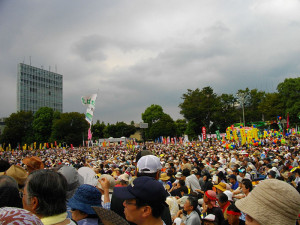By Kendra Ulrich*, 15 September, 2014 Greenpeace — Every birthday is special – but today Japan is celebrating something unique. Japan has been nuclear-free for one year.
Nuclear-free – a phrase that in its simplicity carries a devastating message for the worldwide nuclear industry, and an inspiring lesson for people across the globe. The future can indeed be free of the threat of another Fukushima disaster.
One year ago today, the last commercial nuclear reactor operating in Japan was shutdown. It joined the other 47 nuclear reactors that had been idled for most of the period since the devastating Fukushima catastrophe in March 2011.
[media-credit name=”Anti-nuclear power plant rally on 19 September 2011 at the Meiji Shrine complex in Tokyo | Wikimedia Commons” align=”aligncenter” width=”300″] [/media-credit]
[/media-credit]
Japan is the world’s third largest economy, with 130 million people, and with the largest number of nuclear power plants after the United States and France.
Except none have operated for 12 months. And, not only were there were no electricity blackouts, but Japan came in second worldwide for installing solar PV in 2013 (only China installed more). This was a massive and rapid expansion.
In fact, the total collective time when Japan’s 48 reactors have not been operating amounts to 152 years – over a century and a half when they generated zero electricity. (One reason why nuclear reactors are not built by the market but subsidized by the state and/or foisted onto ratepayers.)
What sort of industry can believe it still has a future when all of its nuclear assets stop generating, on average, for three and half years?
An industry that for decades has sucked billions from taxpayers and has defied logical justification, whether it be judged on economic, environmental, security or human health grounds.
And in Japan, the nuclear industry has collapsed. While the global nuclear industry was in decline before the Fukushima disaster, the impact of the catastrophe has accelerated the already rapid decline of the industry, and opened space for the major growth of renewables.
The majority of Japanese citizens, when polled, consistently oppose plans to restart the country’s nuclear reactors. After all, Japan has functioned perfectly well for an entire year without nuclear electricity. Why risk another disaster with an outdated technology that is not needed?
In addition, the people’s dedication to energy efficiency – the cheapest and quickest way to reduce costs and carbon emissions – has led to a reduction in electricity demand equal to 13 nuclear reactors. At the same time, citizens are installing thousands of micro solar PV every month.
Yes, there is a long way to go. A nation that for half a century based its energy policy on fossil fuels and nuclear power cannot turn overnight into a carbon-neutral, renewables paradise.
But Japan can move in that direction. Renewables are the current trend, and the future. In fact, it’s a very near future, with the potential for renewable energy to supply more than 40% of Japan’s electricity by 2020.
Efforts by the Abe government to fast track nuclear reactors back into operation have so far failed. Major obstacles remain for the two at the top of the restart list, the Sendai reactors in Kagoshima. Seismic and volcano risks remain ignored by the reactor owner and regulator – not a smart strategy for an industry that lost all public trust as a result of the human-made Fukushima catastrophe.
The tragedy of the 2011 Fukushima disaster continues to affect hundreds of thousands of people. If ever an entire nation deserved a happy birthday, today’s one-year, nuclear-free anniversary Japan is it.
After all, out of the darkness of a nuclear catastrophe, Japan is marking the birth, one year ago, of the future: a future that is safe, clean, and renewable. A very, very, Happy Birthday to you, nuclear-free Japan.
*Kendra Ulrich is an energy campaigner with Greenpeace International. This report appeared on Greenpeace International. Go to Original.
2014 Human Wrongs Watch










